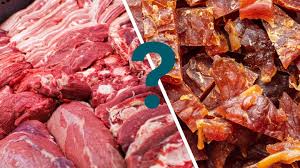Meat has been a staple food for centuries, prepared and preserved in various ways to enhance taste and longevity. One of the most common preservation methods is drying, which removes moisture and intensifies the meat’s natural flavors. Fresh meat, on the other hand, is prized for its tenderness and versatility in cooking. But when it comes to flavor, which is better? Let’s dive into the key differences between dried and fresh meat.
Flavor Comparison: Dried Meat vs. Fresh Meat
Dried Meat: Intense and Concentrated Taste
Drying meat removes water, leaving behind concentrated proteins, fats, and natural flavors. This process enhances the umami and savory qualities of the meat, making it richer and more robust.
- Smoky and Salty Notes – Many dried meats, like jerky or biltong, are seasoned with salt and spices, intensifying the taste.
- Chewy Texture – The texture of dried meat is firmer, requiring more chewing, which allows the flavors to develop fully in the mouth.
- Fermented or Aged Nuances – Some dried meats, like prosciutto or salami, develop complex flavors over time due to curing and fermentation.
Fresh Meat: Natural and Juicy Flavor
Fresh meat retains its natural juices, leading to a milder, more subtle taste that adapts well to different cooking methods.
- Tender and Moist – Fresh meat has a succulent quality that enhances the eating experience, especially when grilled or slow-cooked.
- More Neutral Taste – Unlike dried meat, fresh meat absorbs marinades, seasonings, and sauces, allowing for greater versatility.
- Variety of Textures – Depending on how it’s cooked, fresh meat can be tender, crispy, or fall-off-the-bone soft.
Nutritional Value: Which Is Healthier?
Dried Meat
- High in Protein – Due to water loss, dried meat has a higher protein concentration per serving.
- Low in Fat – Drying removes some fat, making it a leaner option compared to some fresh cuts.
- Higher Sodium Content – Salt is often used for preservation, making dried meat higher in sodium, which may not be ideal for those watching their intake.
Fresh Meat
- Retains Natural Nutrients – Vitamins like B12, iron, and zinc remain intact without excessive processing.
- Lower in Sodium – Unlike dried meat, fresh meat isn’t preserved with high amounts of salt.
- Contains Healthy Fats – Fresh cuts may contain beneficial fats that contribute to flavor and nutrition.
Culinary Uses: How Are They Best Used?
Best Ways to Use Dried Meat
- Snacking – Jerky, biltong, and dried sausages are excellent protein-packed snacks.
- Soups & Stews – Dried meats like beef jerky or salted pork add deep, umami flavors to broths and stews.
- Travel & Emergency Food – Due to its long shelf life, dried meat is ideal for hiking, camping, and emergency supplies.
Best Ways to Use Fresh Meat
- Grilled or Roasted – Fresh meat shines when cooked over an open flame or in the oven, allowing for caramelization and tenderness.
- Slow-Cooked Dishes – Braised meats and stews benefit from the moisture retention of fresh cuts.
- Marinated & Pan-Seared – Fresh meat readily absorbs seasonings and marinades, making it versatile for many cuisines.
So, Which One Has More Flavor?
It ultimately depends on what you’re looking for.
- Dried meat has a more intense, concentrated flavor due to moisture loss and seasoning. It’s great for those who enjoy bold, umami-rich tastes.
- Fresh meat offers a more natural, juicy flavor and is highly versatile in different cooking methods.
If you love strong, smoky, and chewy meat, dried is the way to go. If you prefer tender, juicy meat that can be seasoned to your liking, fresh meat is the better choice.
Final Verdict:
Both dried and fresh meat have unique qualities that make them appealing in different contexts. Your choice depends on personal preference, health considerations, and how you plan to use the meat in your meals!

